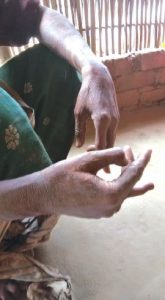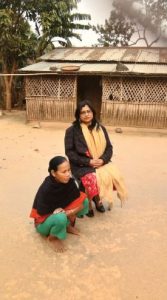 On the fateful night of August 1, a horrific incident took place in Chirang district in Assam. Two families were dragged out of their homes and brutally assaulted on the suspicion of being ‘witches’ and ‘practicing sorcery.’
On the fateful night of August 1, a horrific incident took place in Chirang district in Assam. Two families were dragged out of their homes and brutally assaulted on the suspicion of being ‘witches’ and ‘practicing sorcery.’
The locals of Bhurbasti village attacked Parmeswar Sutradhar, his wife Manjula Satrudhar and Gendi Basumatary, based on the rumour about the two families practicing sorcery, which they thought was the reason behind villagers suddenly falling sick. The timely intervention by the police resulted in the family being rescued, but the social stigma of being branded as ‘witches’ will remain with them forever.
In another incident at Chokoli Pathar village in Golaghat, Assam, 68-year-old Lakhiram Kheruwal was killed on the suspicion of being a ‘witch’ by the villagers in April this year. Days before Kheruwal was killed, he and his wife were physically assaulted and threatened with dire consequences by the villagers who accused them of bringing miseries and disease to the village. The villagers feel no remorse for what they did, instead they boast about murdering Kheruwal.
Last year too in another witch hunting case, Nirjoy Rabha, a native of Kokrajhar, Assam, was beaten to death after being branded as a witch and blamed for practising witchcraft. The agitated villagers believed the rumour that Rabha did black magic on a 16-year-old boy who was not recovering from illness.
Once a witch, always a witch — that’s how it is in the rural heartlands of Assam. Once you are labelled a witch, the tag will remain with you forever, no matter what you do. The superstition and the belief in the existence of witches still exists in many states of India, but in Assam this practice is ubiquitous. Since 1989, hundreds of people have been the victims of witch hunting and meted with severe punishment like mob lynching, rape, sexual assaults, naked parade, public shaming and social boycott from the community. Very often, the people targeted are held responsible for illnesses, deaths, crop failures, property loss, or even natural calamities in their areas.
Women have been the most common prey of witch hunting. Countless women have been ostracised from their villages, and in many cases, sexually assaulted and beaten up after being branded as ‘witches.’ The victims are often branded as witches by the ‘witch doctors,’ commonly called ‘Ojaa’ or ‘Bej,’ or self-proclaimed god/goddess, who the villagers consult on every issue, ranging from illnesses to crop loss, even for family feuds. These uneducated and unqualified ‘witch doctors’ don’t use scientific methods to treat illnesses or seek police help to resolve a feud, but sorcery and black magic. They represent the solution to all the problems faced by gullible locals.
The Mayong village in Morigaon district has been the hub of witchcraft in India from time immemorial, and is also known as the capital of black magic in India. Many mysterious stories from Mayong about black magic, ghosts, witches, etc. have always dominated Assam and have been part of popular folklore. The concept of witchcraft is also deep-rooted in tribal belts of Assam such as Kokrajhar, Chirang and Udalguri districts under the Bodoland Territorial Area Districts (BTAD), KarbiAnglong and Goalpara, which are reported to have the highest number of witch-hunting deaths in the state. Then in upper Assam, areas like Sonitpur, Lakhimpur, Sibsagar and Jorhat also report a significantly high number of witch hunting cases.
According to a research, 196 cases of witch hunting occurred in Assam between 1989-2014. Then in 2019, an Assam politician, Chandra Mohan Patowary, told the Assam Assembly that 107 people had died between 2011 and 2019 due to witch-hunting. In 2018, then Additional Director General of Police (CID) Anil Kumar Jha, said that between 2001 and 2017, 193 people have been branded as ‘witches’ and killed and 202 cases have been registered by the police during that period.
There is no exact data on how many people have been killed, assaulted and outcast from their villages. The number of deaths as per the official records could be hugely understated because it becomes difficult to file FIRs against a community which has committed the crime together, with no individual attacker to lay the blame on. Also, the incidents happen in remote villages, ensuring a very small chance of being spotted by any government agency. Therefore, these cases are unlikely to be counted in the state database.
Speaking to Tehelka, Barnali Sarma Baruah, Director (women cell), Human Rights International Federation, explains the reason on why it becomes difficult to book the perpetrators.
“It is a crime where the whole community is involved, and there are no witnesses, except for kin of the victims of witch hunting, if any. It’s not possible to charge an individual in such scenarios, and getting an FIR filed becomes impossible. In fact, the village headmen are mostly hand-in-glove with the perpetrators, as a result, the accused are never convicted. Though the inhuman act of witch hunting amounts to the violation of Articles 2, 3 and 4 of the universal declaration of human rights. But since there is no awareness among the people, no action is generally taken,” said the human rights activist.
According to her research, witch hunting in the 21st century is nothing but a way to get one’s vested interest fulfilled. “If one investigates the background in witch hunting cases, a common pattern can be observed where the reasons like property issues, denial of sexual favours, jealousy, personal rivalry, land dispute, etc. are the driving force behind this atrocious practice in Assam. It’s actually the poor women who have been an easy target for the perpetrators. It’s also a way to silence rape survivors or sexual assault victims, to prevent them from revealing the identity of the harassers. By branding them a witch in remote villages in such a case of rape or sexual assault, the perpetrators easily get away with impunity,” Barnali said.
What does the Act say?
The anti-Witch Hunting of Assam (Prohibition, Prevention and Protection) Act, 2015, came into effect in 2018 after three years of rigorous push. The Act makes witch hunting a cognizable, non-bailable and non-compoundable offence.
The Act clearly states that whoever identifies, calls, stigmatise, defames or accuses either by words, signs, indications, conducts, actions or any other manner to any person as witch; instigates or aids, shall be punished with imprisonment or a term which shall not be less than three years but can extend up to a term of seven years with fine not be less than 50,000 — but which may extend to 5,00,000 or more.
However, until the law is effectively implemented on the ground, it will change little.
Need of massive awareness
“Awareness meetings and seminars on witch hunting is what is needed in such affected areas every month. Right from the school children to older people, education on legal consequences should be disseminated rigorously. I am hopeful that if we focus on the children and young people on the ills of witchcraft, witch hunting and rumour mongering, we can ensure a massive change in 10 years,” said Barnali.
The Covid-19 pandemic has now come in the way of the efforts to educate the villagers in areas known for witch-hunting.
Psychiatrist Amal Baishya who is currently posted in Karbi Anglong spoke to Tehelka, “To ensure that such an illegal practice of witch hunting and witchcraft comes to an end, an awareness programme jointly by the Karbi Anglong police department and psychiatrists was in the pipeline. But, due to the Covid-19 situation, we had to cancel.”
To eliminate the menace of witch hunting, former DGP of Assam, Kuladhar Saikia, launched Project Prahari as early as 2001. The project was hugely successful in lowering the crime rate, even forcing Bodo militants to leave the Kochugaon area back then. Project Prahari was a catalyst for development in remote areas, so it was very hard for the militants to derail it. The campaign played an instrumental role in bringing together NGOs and activist groups and spreading awareness about the ills of witchcraft. Project Prahari continues to work wonders even to this day by offering people alternative sources of livelihood and eliminating the mindset of superstition and belief in unfounded rituals. Currently, more than a 100 tribal villages in Assam continue to be benefited by Project Prahari.
The prevalence of superstition has also been countered by use of mass media, especially through feature films. Sensing the common prevalence of witchcraft, a feature film by eminent theatre personality, Sitanath Lahkar, Aei Maatite, was released this year in July on the burning issue of witch-hunting. The film became popular in educating the masses in Assam about the ills of practicing sorcery.
The people living in the tribal and rural areas in Assam have a very low rate of literacy and are led by blind faith and superstition, which is the basis of their belief in witchcraft. The implementation of laws is crucial, but what will really stop these blind beliefs is social awareness and mass sensitisation. Merely making strict legislation will be hardly sufficient to expose people to modern thought and ensure a civilised society.
The fact that such practices exist in the 21st century presents a scathing indictment of our society and the rule of law. Despite being ubiquitous in Assam, practice of witchcraft is not being given priority by the government and scores of men and women continue to be victimised and killed every year. The solution doesn’t just lie in the creation and implementation of effective laws, but good administration. The solution lies in curbing the menace at its roots i.e. from the minds of people, through education, mass sensitisation, modernisation and development in these areas. Since the practice is mostly used against women, the government needs to come up with women empowerment schemes and programmes, health facilities and employment opportunities for the youth. Until such initiatives are fully taken, eliminating this ancient practice from the rural heartlands of Assam will be impossible in the near future.
letters@tehelka.com













